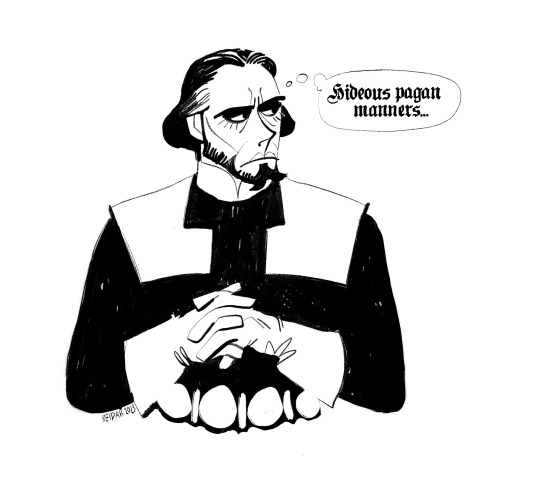#teutonic knights
Explore tagged Tumblr posts
Text
I am in love with Tumblr because there is literally anything. Ever fanart of Ulrich von Jungingen!



yea
3K notes
·
View notes
Text

theyre so cute im gonna eat them
#artists on tumblr#digital art#hetalia#hetalia fanart#hetalia world stars#aph romano#hws romano#hws south italy#prumano#gilbert beilschmidt#hetalia prussia#aph prussia#hws prussia#Chi Italia#Chibi romano#teutonic knights#Adorable babies#sobbing crying throwing up#Yes he gave romano his cape
96 notes
·
View notes
Text

53 notes
·
View notes
Text

#teutonic order#teutonic knights#battle on the ice#art#teutonic#knights#knight#medieval#middle ages#germanic#history#chivalry#northern crusades#crusades#crusaders#crusade#crusader#lake peipus#estonia#russia#christianity#christian#battle of lake peipus#europe#european
295 notes
·
View notes
Text
And here I thought how Ulrich von Jungingen felt himself in such armour in summer of 1410. Despite of Little Ice Age it should be hard to ride few miles, to wait those bastards at Tannenberg field and to fight after all!
Poor thing...
How a Man Shall be Armed. English Knight ca 1415
Source
2K notes
·
View notes
Text
oh honey i WILL yap about how knights templar and teutonic knights prussia is similar to david and jonathan from the bible and YOU WILL listen to me.
#heh...#hetalia#the bible#david and jonathan#david the bible#jonathan the bible#teutemp#teutonic knights#hetalia teutonic knights#hetalia knights templar#knights templar#gilbert beilschmidt#hws#aph#hetalia axis powers
43 notes
·
View notes
Text

„Kesesesesese“ 🐥🐣
#hetalia#hetalia art#hetalia fanart#hetalia the beautiful world#aph hetalia#axis powers ヘタリア#hetalia axis powers#hetalia the world twinkle#hetalia world series#doodles#hetalia prussia#gilbert beilschmidt#aph prussia#hws prussia#ヘタリア#ヘタリア world stars#ヘタリアaxispowers#beer#i am awesome#hetalia gilbert#Preußen#teutonic knights#mr.engineer#i imagine his handwriting to be immaculate#my mom said he’s handsome XD#hws#aph#my not-so-secret bookworm#gilbird
28 notes
·
View notes
Text
Saints and monsters...









The Gothic monumental Church of the Blessed Virgin Mary in Toruń is a true medieval gallery of authentic paintings that take the viewer to a completely different world... How did medieval people see the world? I don't think we know it, but these centuries-old paintings give a lot of clues for the imagination. There are not only saints on them, but also monsters, buildings and strange places.
Will you buy me a coffee?
#gothic#goth#frescoes#medieval art#medieval#middle ages#photographer#photography#photoshoot#photograph#photo set#gothic architecture#gothic art#monsters#saints#historic#historic art#history#europe#unesco#prussia#poland#teutonic land#teutonic#teutonic architecture#teutonic order#teutonic knights#temple#gothic temple#church
20 notes
·
View notes
Text
Teutonic Knight

#anime and manga#art#comics#illustration#manga#anime#my art#russia#japan#china#artists on tumblr#teutonic knights#teutonic knight#teutonic#knight#knights#teutonic order#history#christianity#christian
16 notes
·
View notes
Text

13 notes
·
View notes
Text
YOU ALREADY KNOW WHAT WE ABOUT BE ON!!!

TIME TO SHOW THOSE ELDRITCH FUCKERS SOME HOLY SPIRIT!!!!
#memes#crusaders#crusader memes#knights#knights templar#teutonic knights#knights hospitaller#darkest dungeon#darkest dungeon crusader#we crusading on this bitch
27 notes
·
View notes
Text

PL:
Zamek krzyżacki, Malbork, Polska
Zamek w Malborku pełen jest legend i tajemnic. Jedną z najbardziej znanych jest historia Marii z Brzozowej, która miała rzekomo zostać zamurowana żywcem w jednej z komnat zamku. Według innej legendy, pod zamkiem miała znajdować się kryjówka, która skrywa skarby Zakonu Krzyżackiego. Oczywiście, nie ma potwierdzenia, że te historie są prawdziwe, ale to właśnie one sprawiają, że Malbork jest jeszcze bardziej tajemniczym i intrygującym miejscem.
EN:
Castle of the Teutonic Order, Malbork, Poland
Malbork Castle is full of legends and mysteries. One of the most famous is the story of Maria of Brzozowa, who was supposedly bricked up alive in one of the castle's chambers. According to another legend, there was supposed to be a place under the castle that conceals the treasures of the Teutonic Order. Of course, there is no confirmation that these stories are true, but they are what make Malbork an even more mysterious and intriguing place.
#malbork#zamek#castle#poland#polska#architecture#architektura#widok#landscape#historia#history#gothicarchitecture#gothic architecture#architekturagotycka#architektura gotycka#krajobraz#krzyżacy#zakon krzyżacki#teutonic order#teutonic knights#teutonicorder
3 notes
·
View notes
Text

Erks Mānts (Herkus Mantas) - the most famous leader of the Great Prussian Rebellion against the Teutonic Knights and Northern Crusaders.
lllustration by Arvydas Každalis.
7 notes
·
View notes
Text



Huno and the Shapeshifter
Artfight attack; parody of St. George and the Dragon featuring @beidak-art's OC
#dog draws#shapeshifter#fae#dragon#teutonic knights#medieval fantasy#horse#sure yeah those tags work i think#artfight#artfight 2024
8 notes
·
View notes
Text

Portrait of Maximilian Josef of Austria-Este (1782-1863), member of the Teutonic Knights. . By Adeodato Malatesta.
#haus habsburg lothringen#house of habsburg lorraine#erzherzog#ducato di modena#casa d'este#austria este#österreich este#teutonic knights#italian aristocracy#Deutscher Orden#Domus Hospitalis Sanctæ Mariæ Teutonicorum Hierosolymitanorum#adeodato malatesta
3 notes
·
View notes
Text

Alexander Nevsky by Nicholas Roerich
#alexander nevsky#art#nicholas roerich#symbolism#symbolist#landscape#battle#russia#russian#battle on the ice#battle of lake peipus#novgorod#teutonic knights#teutonic order#knights#history#crusades#crusade#middle ages#medieval#northern crusades
96 notes
·
View notes